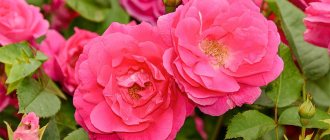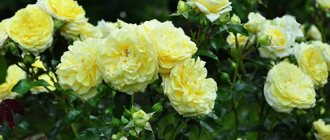Do you want to make a beautiful flower garden from tea-hybrid, climbing or floribunda roses, but don’t know where to start? Then this article is for you! In it you will find answers to the most common questions that beginners have when arranging a rose garden.
A beautiful, lushly blooming flower bed with roses under a window or next to a seating area is the dream of almost any avid gardener. If you are also dreaming of your own rose garden, find out how to set it up correctly and what varieties of roses to choose so that they combine well with each other and harmonize with your garden. And Becker company specialists will help you with this.
Where to place a flower bed with roses on the site
To choose the right location for your rose garden, you need to consider several factors:
- all roses love the sun very much, so the flowerbed should be well lit;
- it should be located in a clearly visible place so that you can admire it from different points on the site;
- the place should be protected from drafts and cold winds, but at the same time air should circulate freely there.
To get a good view and access from any direction, plant a rose bed in an open area of the yard or near a seating area .
You can also plant bushes along the edge of the lawn along the garden paths - roses will look great here.
Another good option is to place a rose garden near your house . In this case, give preference to the eastern side, because the lighting there will be optimal.
Place the rose garden near the house in such a way that the walls and fence are not shaded by bushes. Also, do not forget to leave wide paths for passage so that you can comfortably move around the site without fear of pricking yourself on the branches.
Shrub roses and landscape options
When planting bush varieties for the first time, you should not immediately take on weaving arbors or building hedges; you should learn from simpler things.
Simple ways to revitalize an area with live roses:
Flower beds - bush roses are placed around the site in beautiful, specially prepared places.
Borders are bushes, the easiest to care for, planted around the perimeter. In some cases, this is simply a living frame for the path, in others, grooves are formed for them from brick and stone, or twisted decorative fences are installed in front of the bush line.
Group – a territory is selected on which only the rose garden will be located. The bushes can be arranged by variety or color - you will get a cozy corner for relaxation in the Provence style, where you can put ordinary plastic chairs, a table with an openwork tablecloth and a white garden umbrella.
If the roses take root well, you can safely take on and form hedges, large arches, and weave them around walls and gazebos.
Small flower garden or big?
The main thing to consider when planning the design of a future flower garden is the size of the plot. It is recommended to plant a small space with low and medium-growing species and varieties of roses (ground cover, hybrid tea, floribunda, low park). But in a large garden, do not limit yourself to just spreading and tall specimens (climbing, standard, tall park). They are best combined with medium-sized rose bushes (the tallest ones in the center, the shorter ones at the edges). Then the flowerbed will look voluminous and elegant.
To ensure that your rose garden delights with colorful colors throughout the summer, it is advisable to plant varieties with different flowering periods.
Also think about the number of bushes in advance. An insufficient number of plants will create the effect of a “bald” flower garden, and bushes planted too closely together will oppress each other, which is why your roses will become sick more often and bloom less.
| Optimal distance between bushes for different types of roses | |
| Dwarf and undersized species and varieties | 25-45 cm |
| Hybrid tea and medium-sized park teas | 65-100 cm |
| Standard and low-growing climbing | 50-100 cm |
| Tall park trees, weeping standard trees, vigorous climbing trees | 1.5-2 m |
Loving care for the flowerbed
When the layout of the rose garden is over, it’s time to think about systematic care:
- It involves moderate watering of the topsoil. Particular attention is paid to the speed of its drying and the amount of precipitation that falls during the growing season of the plant.
- Spring pruning is carried out on dry, sunny days, taking into account the variety of crops.
- In preparation for winter, the bushes are generously fed with phosphorus fertilizers, and reliable shelters are also built.
As it turns out, creating a rose garden at your dacha with your own hands is a fascinating undertaking. It requires serious preparation. First, a suitable site is selected. Then they draw up a plan and layout of the crops. The varieties of roses are determined and planting begins, according to agronomic rules. In order for a spectacular valley of “royal” flowers to appear at the dacha, it is provided with competent care. And may our life path be strewn with rose petals.
How to choose the right color scheme for a rose garden
For a garden to delight with its exquisite beauty, it should not contain “random” plants purchased spontaneously. The same rule applies to rose flower beds.
A good option is roses of the same variety or color. But it’s even better if your flowerbed has flowers of different shades. This way you will achieve extraordinary versatility and get a beautiful curtained composition. However, do not overdo it - a flower bed that is too colorful, cast in all the colors of the rainbow, looks untidy and quickly tires.
Here are a few color combinations that have already become classics and would be appropriate in almost any garden:
- an elegant and peaceful flowerbed consisting of white or green roses (recommended varieties are Bolero, Lovely Green, White Diadem, Iceberg, Mont Blanc);
- flowerbed in pastel colors , consisting of roses with cream, soft pink, white and lavender flowers (recommended varieties - Blue Perfume, Flamingo, Belle Ange, Princess Margaret, Gloria Climing, Pomponella, Dolce Vita, Sweet Honey, Novalis, Pink Diadem, Elina, Helena);
- bright flowerbed consisting of roses of yellow, red, orange and lilac (recommended varieties are Red Intuition, Gloria Day, Mister Lincoln, Freesia, Indigoletta, Casanova, Burgundy, Masquerade, Monica, Orange Sensation, Cherry Girl, Arthur Bell);
- contrasting flowerbed , consisting of two shades that successfully combine with each other, for example, red and white, lilac and yellow (recommended varieties are Royal Williams, Black Magic, Black Cherry, Pascals, Blue Fo Yu, Love Song, Ebb Tide, Big Purple , Cardinal, Golden Monica, Landora);
- unusual flower bed , consisting of main plantings in the form of roses in pastel colors with individual bushes as bright accents, for example, roses of delicate shades, diluted with bushes of raspberry, purple or orange colors (recommended varieties - Chopin, Vanilla Perfume, Cherry Brandy, Julia Child, Ingrid Bergman, Bicolette, Pink Intuition, France Libre).
When arranging a rose garden, it is recommended to plant rose bushes in groups (at least three copies), consisting of identical varieties or roses of the same color. Such islands look much better than scattered single specimens.
Drawing up diagrams and breakdown plans
When choosing a rose garden planting scheme, pay attention to the color scheme of rose blooms and dilute its diversity with perennials or evergreen shrubs. Conifers or ferns will not only create an advantageous backdrop for viewing the rose garden, but will also add picturesqueness to this corner of the dacha when the roses fade. You can get some ideas on how to create a rose garden in your garden plot with your own hands in the form of group planting of roses from the diagrams below.
When planting roses in a group, you need to think about which perennial and evergreen plants will highlight their beauty.
At the initial stage of creating a rose garden, it will be useful to draw a sketch of the placement of roses in a group
A rose garden created from a combination of white or cream roses with perennials and blooming lilac inflorescences looks original.
The planning diagram of the rose garden will help to mark out the area allocated for the arrangement of the flower garden
What can you combine roses with in a flower bed?
Of course, the queen of flowers plays the role of the main violin in any flower garden. But its charm can be enhanced with the help of properly selected “companions”.
Roses combined with annuals and perennials
The main rule in this combination is that the neighbors should be short, located at a certain distance from the rose bushes and not grow too large.
Among the annuals, verbena, cosmos and gillyflower will be good neighbors for roses. Of the perennial flowers, it is best to give preference to lavender, speedwell, delphiniums and dim varieties of asters. Bulbous primroses, chrysanthemums and any short plants with flowers of not very bright colors will also look very beautiful next to rose bushes.
Roses combined with ornamental shrubs
Against the background of the lush greenery of ornamental shrubs, roses look even more charming. The classic combination is flower beds with roses and conifers. Combinations of roses with boxwoods, hydrangeas and clematis are also very popular.
Roses combined with herbaceous plants
Perennial and annual herbs get along well with roses and do an excellent job with their main task - covering the lower part of the bushes, bare areas of the ground and dark corners. The universal “soldiers” here are hostas, speedwell, fescue, and soddy pike. Ferns also go well with roses, but their development must be limited, otherwise over time they will become real aggressors.
The lower part of the bush of many types and varieties of roses does not have a very attractive appearance. To hide this drawback, plant low ornamental plants and flowers next to them, which will act as a kind of frame. For roses in pastel colors, lavender, boxwood, woolly chlorine, and cineraria marina will be excellent companions. For bright roses, plants with golden and purple leaves and flowers are suitable, for example, Thunberg barberry, rosmarinolium santolina, border aster, etc.
Preparatory stage - selection of location
So, you have decided to create a rose garden with your own hands, but you don’t know how to approach this difficult task. First of all, decide which area of the garden you would like to devote to setting up your rose garden. There are a huge number of options for planting roses, but you need to pay attention to the fact that the place for planting the flower garden is sunny, windless, with fertile soil. When forming a rose garden, you should avoid swampy and damp areas of the garden, as well as areas in the shade of trees or buildings. As for the soil, the most successful soil for planting roses is considered to be light loam with an acidity level of 5-6 pH.
Climbing roses look impressive on the facade and in the design of the entrance area of a country house
A flowerbed of geometric roses will be favorably emphasized by a low border of evergreen shrubs
Abundantly blooming rose gardens in a summer cottage can be planted freely, emphasizing the naturalness of the garden, or geometrically, following a clearly thought-out plan. You can plant roses in a group on the lawn or near a pond, use roses to create a hedge around the perimeter of the garden, or arrange them in a flower bed. A rose garden of low-growing flowers will be an excellent solution for creating a border inside a summer cottage, and climbing varieties of roses will favorably highlight the architecture of a gazebo or pergola, and hide an inconspicuous wall of a house or fence.
You can learn more about the features of planting and caring for climbing roses from the material:
Even a single standard rose planted in the form of a tree or a spreading bush of hybrid tea rose can transform the landscape of a dacha. Tall park roses will fit perfectly into the design of the entrance to the site or add solemnity to the long alley leading to the house. Roses will become a truly royal decoration for any corner of your garden plot, adding the missing “zest” to its appearance and filling your garden with a delicate fragrance.
How to care for roses
To ensure that your flowerbed continues to delight with bright colors and abundant flowering, do not forget to regularly water and feed the plants (in the spring and first half of summer with complex fertilizers with a predominance of nitrogen, in the second half of summer and autumn - with fertilizers with a predominance of potassium and phosphorus), and also cut faded buds. Prune the bushes annually, first of all cutting out all broken, disease- and pest-damaged shoots, as well as thick, fattening shoots. Be sure to cover weakly winter-hardy species and varieties for the winter, removing all leaves before doing so.
How long have you been wanting to create a beautiful rose garden? Stop dreaming, it's time to get down to business! With Becker it is very easy to do this. Visit our website, check out the new products for 2022 and order your favorite varieties of roses by mail.
We work only with the best nurseries in Russia, Poland and Holland. Therefore, we guarantee high quality seedlings and planting material.
What makes bush roses different?
- A variety of flower shapes - from classic to terry tea hybrids.
- Long flowering period from May to late autumn.
- Rapid growth - in the summer alone the bush can grow up to 2 m.
- Resistance to temperature changes and ease of maintenance.
- An unusual and strong aroma of flowers.
- Large selection of colors: from cream to lilac and even striped.
- Successful alternation of growth and death of flowers - the bush never ceases to bloom and delight with beauty.
- Shrub roses can be grown even at home in a regular pot.
The choice of one or another variety of roses depends on the goals of landscaping the territory. Many people completely change the position of the bushes and the details of the landscape of their summer cottage every two or three years.
Mini roses
They are like smaller copies of ordinary roses.
But this smallness is where their beauty lies. The height of the bush is 20–40 cm, the flowers are small, arranged in a cluster, often double. Their small size makes it possible to use these roses to implement interesting landscape ideas, for example, arranging rockeries with roses. Typically, these roses are grafted, which allows them to maintain their small size. They bloom from mid-summer to autumn, for quite a long time. The colors are varied: from delicate to very bright shades.
These roses, like hybrid tea roses, are quite demanding to care for: they require regular abundant watering and fertilizing, they do not tolerate dry air, are often affected by pests and do not like their roots being disturbed. They prefer open air, so they are not at all suitable for home breeding.
For some reason, they stubbornly continue to try to grow mini-roses in the apartment. Their size plays an important role here - it seems that these roses are “homemade”. However, they can live in an apartment for no more than 4 months.
Rose Martin Frobisher (Martin Frobisher)
This rose opened the Explorer series of Canadian varieties. It was released back in 1968. In appearance, it is a spreading bush up to 1.7 m high with upright growing shoots, strewn with pale pink flowers 5-6 cm in diameter all summer.
The varieties of roses of Canadian selection have two varieties - park and Explorer, which means “researcher”. The symbolism of the latter lies in the fact that each of these plants gets its name after one of their discoverers.
Preparing roses for winter
Roses must be covered for the winter. There are many different ways to do this, but not all of them are equally good, since the rose is also very afraid of getting warm.
Rose needs a warm “house” for the winter, but with good air exchange. In principle, the type of house is the same for climbing roses and for all others. The best option is a wooden box plus two layers of dense spunbond on top. Such a shelter is both warm and breathable.
Instead of a wooden box, you can use a garden construction set placed crosswise, stretch two layers of dense spunbond onto it, and put plastic film on top.
They don’t do anything with ordinary bush roses, but the climbing rose must first be removed from the support (this is the most difficult thing - it is noticeably prickly). Therefore, it is better to purchase a flexible special support for it, which can be removed from the main support (arches, arbors) and placed together with the rose. Then cut the shoots by 1/3, roll them into a ring and place them in a “house” on a layer of sawdust or a sheet of foam underneath.
DIY rosary. Common mistakes.
Growing roses can be a fun and beautiful hobby. But even the most experienced summer residents make mistakes, or rather, they don’t do what’s important. And your rose garden in the country may not look the way you planned! Do not worry. Here are some common mistakes when growing roses and easy ways to correct them.
- Don't test your soil. Soil is essentially to a plant what your refrigerator is to you. And it’s important to know if your roses are getting all the nutrients they need. An easy way to check is to purchase a soil indicator test that will check your pH balance as well as nitrogen and phosphorus levels. It is important to do this every year, because... the soil changes from year to year; Moreover, even the soil in different parts of your garden may differ - this also needs to be tested.
- Improper watering of roses. You're probably thinking, "No, that's not me - I water my roses regularly." But, if you water your roses incorrectly - only the tops of the bush - then this is not the most effective way. Roots need moisture most, and wet leaves and stems can become a breeding ground for fungi and diseases. Consider drip irrigation for roses using a porous hose that slowly disperses water through its capillary walls.
- Not using compost regularly. Adding compost to your soil is the best way to enrich the soil in your garden. Make your own compost bin and regularly use compost for feeding and your rose garden will become bigger and more beautiful!
- Ignoring rose pests. Rose pests can be silent but deadly. Before you know it, aphids and other rose pests can simply destroy your rose garden. Pest control may seem difficult to you, and you will try to avoid using chemicals on your property. Don't worry—there are many natural rose pest control options that are safe for your garden, your family, and your pets.
- Do not use mulch on roses. Don't let your gardening work get lost in the sand. One of the most common, but easily corrected, mistakes when growing roses is not using mulch. Mulching is a way to ensure that your soil retains moisture, and some types of mulch also enrich the soil. Mulch not only protects your plants, but also helps them grow stronger! There are many different types of natural mulch - choose the one that is most affordable for you.
You see that there is no reason to worry! All difficulties and mistakes that relate to the question of how to make a rose garden in the country are easy to solve and correct.
With patience, determination and a love for roses, you will soon see the results of your gardening work!
Care
In order to observe beautiful roses in the country, you should care for them properly. This includes loosening the soil, proper fertilizing, disease control and other important processes for preserving the flower.
Feeding plays a significant role in the development of roses. The first procedure is carried out in spring, the second - in mid-summer. At the end of this period, you should not fertilize to avoid the appearance of shoots.
You can choose the necessary complex, maintaining balance and moderation. After all, exceeding the norm will entail unpredictable results. At best, you will get improved plant growth, at worst, they will stop growing completely.
Alternate manure and compost for fertilizer every 2-3 years.
Water in the morning or evening once a week. The soil around the bush should be loosened so that the soil is saturated with oxygen.
Pruning occurs in the spring before the buds begin to awaken. Sick, weak stems should be removed. Both weak and strong pruning are used for this process. Use a sharp tool to minimize the risk of damage and wounds to the bark.
At a time when cold weather sets in, it is worth considering shelter. There are certain types of roses that can survive cold, unfavorable conditions without shelter. According to experienced gardeners, it still needs to be used. Begin this process in early November.
Avoid excessively wrapping plants or covering them with spruce branches. Because of this, the roses will die. For shelter, use peat, or just loose soil. The layer should not exceed 10-15 cm.
In one season, it is necessary to spray roses with special means about three times. This will protect the plant from fungal diseases, pests, or rust.
Rose Rhapsody in blue (Rhapsody in blue, Blue Rhapsody)
Another unpretentious variety belonging to the floribunda group. In addition to the fact that it can be distinguished from many other roses by the color of its buds with purple-violet flowers, it is also characterized by increased winter hardiness and disease resistance, which greatly simplifies the care of this plant. The rose blooms continuously throughout the summer, and its bush can grow up to 1 m in height.
Translated into Russian, Floribunda means “blooming abundantly.” Roses of this group were obtained by crossing dwarf polyanthus roses with hybrid tea roses.
- What types of roses are there - an overview of groups, types and varieties
Classification of roses and description of their main groups with a list of popular varieties.
Shrub roses
This is the least common type, although it deserves to be used more widely. Although these roses are less decorative than all of the above, they require virtually no care, and for many corners of the garden, especially inconvenient ones, they are irreplaceable.
In appearance, these roses resemble tall rose hips, but they have more beautiful flowers, usually double. The bush is very tall, at least 1 m tall. Flowering is mostly once, the flowers are lush and fragrant.
Overall, this rose has a country or eco feel to it, it's such a natural look. It can also be used for landscaping the external area outside the perimeter of the site, as well as for hedges.
Floribunda roses
Roses are also very beautiful, although in terms of flower appearance they are, of course, inferior to hybrid tea ones. Their flowers are smaller in size, 5–9 cm, more “loose” in shape, and are not arranged separately, but in clusters. They are less fragrant. Bush height - 60–70 cm; but there are low varieties, no higher than 45 cm. Such roses are suitable for growing in containers.
Floribunda roses have obvious advantages: they bloom all season, look very bright (brighter than hybrid teas), can be containerized, and most importantly, they are very unpretentious, are not afraid of dampness, are rarely affected by pests and diseases, and are quite frost-resistant.
Ideas for planting rose bushes
There are quite a lot of options where you can plant roses in your garden plot. The external beauty of the rose garden depends on the size of the selected area, the garden fixtures located nearby, and the wishes of the owner of the estate.
Plants are planted:
- As a hedge. Planting flowers around the fence separates the garden from the yard, giving it a style that is consistent with the entire area.
- At the entrance door to the building. If there is enough space near the main entrance, then they create beautiful compositions using the species and variety of roses. If there is little space, climbing varieties are often used.
- Along the paths. The paths in the garden are decorated not only with standard and bush roses, but also with beautiful arch compositions.
- Separate places in the garden for relaxation. Roses create coziness, and their incredible aroma will inspire relaxation and romance.











